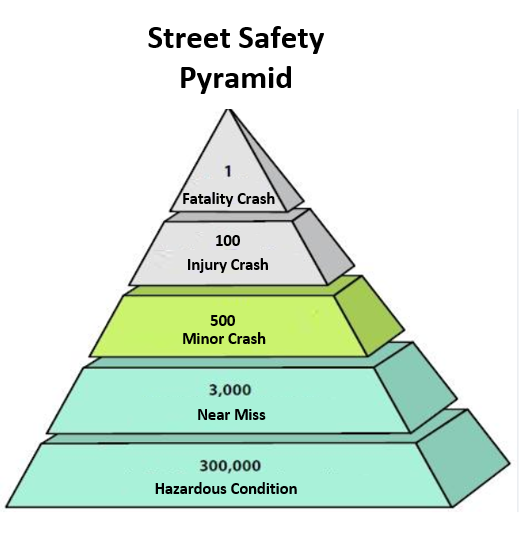Street Safety - Safety Pyramid Revisited
A couple of weeks ago I introduced the notion of a safety pyramid. Now that we've dug through some of the needed changes and the ramifications of culture, I though we could revisit the model and hit the high point. I'll add a few cautionary notes, too.
For reference, here's the pyramid again, with modestly updated numbers as I've attempted to find decent statistics. Ideally, we'd each calibrate these for our cities and then manage the whole pyramid down in size. Recall that the general assertion of this model is that it is not usually possible to chop off the top of the pyramid, but that action must be taken at the lower layers (improving the slices of cheese in our avoidance model) to reduce the top layers, as these manifest as statistical inevitabilities.

Unfortunately, as we've outlined in the intervening blogs, we cannot hope to have a healthy, robust safety system to create and improve a robustly safe street network without better responsibility. We could easily talk about adding web- and mobile-apps for reporting hazardous conditions and near-missed, but does it make sense to get more data which will only be ignored?
Already we have reams of actionable data, and our best practices wait for deaths to stack up before action is taken as purely remedial activities, not proactive in the least. Already some cities have "road audits" which are much like safety observation tours taken in industrial settings, but unless the findings are leveraged to address underlying issues, why do we bother?
The crux of the issue is that we've designed a Libertarian-style system "everybody is responsible for themselves", and then we've included in the mix children (16 to 18 year olds, in most states) driving cars, and children (of any age) as street participants. For legal responsibility, this completely fails unless a responsible adult must always be with every such child, but in practice it fails even worse as adult drivers are generally also not responsible for "accidents" as long as they don't flee the scene. And when they do, only a small fraction of hit-and-run crashes are investigated and solved. Instead, we make children responsible for the intentional street designs created by adults with vested interests.
We cannot permit a system to remain where NOBODY is responsible, and more-so when the non-responsible primary players also represent single-point-of-failure vulnerabilities, and more-so still when we force these participants to interact on conflict-ridden stroad. It's an idiotically ineffective approach.
https://www.strongtowns.org/journal/2013/3/4/the-stroad.html
Where are the "responsible adults" in the system? Most reside in various bureaucracies, in police departments, and in elected officials. We MUST create a system where if responsibility slides off one party, it must land on another. If we choose not to charge a teen driver for running over cyclists, then police leadership or an elected official should face an inquisition. If we choose to build frail systems, the designers and their management should face the same. Career impacts and where negligent behavior is evident criminal charges should be routine. If nobody is responsible, the we ALL are responsible.
But mostly, waiting for statistically inevitable crashes then looking to punish somebody is the wrong way to think though it's apparently the American norm, just as considering policing to be a solution to crime always is, as you get full jails but more crime and nothing fundamentally fixed. We should instead provide incentives to proactively make changes to improve safety despite the inattention, contrary behavior, and faulty thinking of drivers, just like we do today to improve traffic flow and highway safety for these same people. Most changes need to be in concrete and steel, to make a real difference that is not subject to driver whims and errors.
Other mitigations could include increasing driver minimum age to adulthood, adding insurance surcharges by class of vehicle and miles driven to fund crash prevention, implementing presumed liability by hazard level vs vulnerability level in crashes, and requiring multi-disciplinary safety investigations of every fatality crash and every asymmetric crash between different classes of vehicle with accountability for follow-up.
In terms of immediate improvements, though, the answer is already obvious: reduce speeds! If we do not have robust modal separation, with multiple slices of cheese to mitigate conflict points, then vehicles must go slower. It's simple, easy, and well-proven. and it provides a natural incentive for drivers to support modal separation infrastructure investment. Have neighborhood streets operate at human speeds, matching that of the most vulnerable mode present in the mix, and have connecting roads require modal separation and controlled access. Get rid of stroads and the incompatible mass/velocity/direction mismatches which they foster.
Comments
Post a Comment